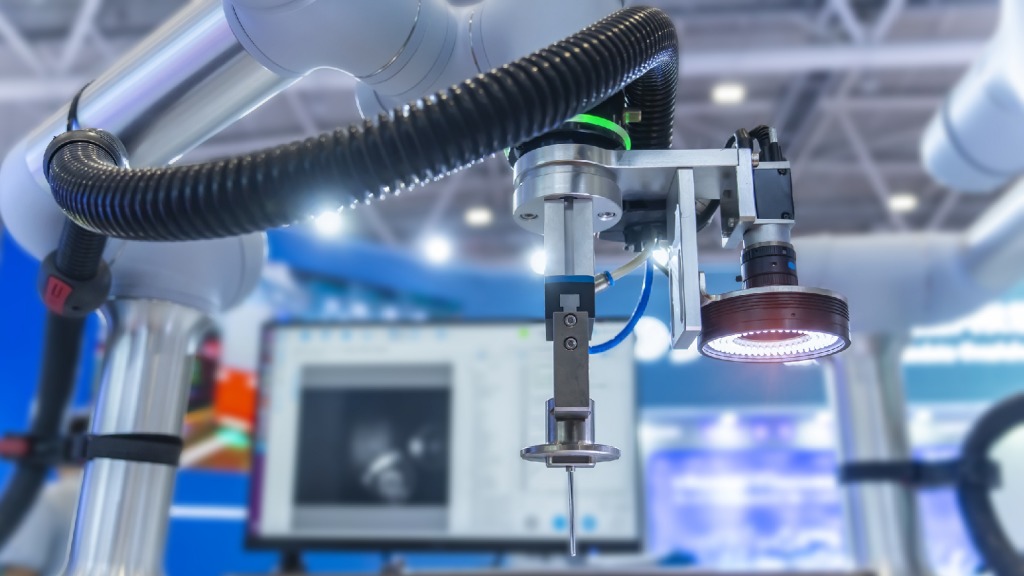As the world enters the era of Industry 4.0, also known as smart manufacturing, technology is evolving rapidly, reshaping industries by integrating automation, data exchange, and digital technologies. One of the cornerstones of this transformation is the machine vision system, a technology that uses advanced imaging capabilities and artificial intelligence (AI) to automate critical processes in manufacturing.
Machine vision systems play a vital role in tasks such as object detection, defect detection, surface defect detection, and object counting. These systems enable companies to streamline their operations, increase productivity, and ensure product quality, thus driving the future of manufacturing. In this article, we explore how machine vision systems are transforming the industry in the context of Industry 4.0.
What is a Machine Vision System?
A machine vision system combines high-quality cameras, imaging sensors, lighting, and algorithms to capture and analyze images in real time. The technology interprets visual information from a production environment, enabling machines to make decisions based on predefined criteria. By automating processes that were once manual, machine vision systems increase precision, efficiency, and speed, all of which are vital in today’s competitive manufacturing landscape.
Key Components of a Machine Vision System:
- Camera and Imaging Sensors: Capture high-resolution images for analysis.
- Lighting: Ensures the subject is properly illuminated for accurate detection.
- Processing Unit: Executes complex algorithms for image analysis and decision-making.
- Software Algorithms: Analyze the visual data and automate tasks such as object detection or defect detection.
Object Detection in Smart Manufacturing
Object detection is a critical function of machine vision systems in smart manufacturing. This technology enables systems to identify, classify, and track objects moving along production lines, ensuring proper assembly, sorting, and packaging. Object detection allows machines to “see” and make precise decisions, drastically reducing errors and improving efficiency.
Example Use Case: Automotive Industry
In the automotive industry, machine vision systems are used for object detection to verify that all parts are correctly assembled. Robotic arms, guided by the vision system, can detect whether the right component is in place before moving to the next stage of the assembly line. This process ensures that no defective or missing parts are passed on, reducing costly mistakes and rework.
Benefits of Object Detection:
- Increased accuracy: Systems can detect objects with high precision, reducing human error.
- Automation of repetitive tasks: Labor-intensive tasks such as sorting and assembly are handled by machines.
- Faster production cycles: As objects are detected and processed at high speeds, overall production times are shortened.
Defect Detection: Ensuring High-Quality Production
Another essential application of machine vision systems in smart manufacturing is defect detection. As production lines speed up and become more complex, manually inspecting every product becomes impractical. Machine vision systems solve this problem by automatically detecting defects, such as surface imperfections or structural flaws, in real time. This ensures that only high-quality products leave the factory.
Example Use Case: Electronics Manufacturing
In electronics manufacturing, tiny defects such as scratches or misaligned components can render an entire batch of products unusable. Machine vision systems can identify these defects instantly during production, preventing faulty products from reaching the consumer. These systems also allow manufacturers to identify and correct issues at an early stage, reducing the need for rework or costly recalls.
Benefits of Defect Detection:
- Higher quality control: Machine vision systems detect even minute defects that are difficult for humans to identify.
- Reduced waste: Early defect detection prevents defective products from being further processed, thus reducing material waste.
- Cost savings: Fewer recalls and product rejections mean lower costs in rework and refunds.
Surface Defect Detection: Enhancing Precision in Manufacturing
In industries that rely on pristine surface quality—such as metal, glass, and textile production—surface defect detection is crucial. Machine vision systems excel in surface inspection tasks by capturing high-resolution images and analyzing them for defects like scratches, dents, or other surface inconsistencies. The system’s ability to provide real-time feedback allows manufacturers to catch surface defects early and correct them before they result in product failures.
Example Use Case: Metal Fabrication
In metal fabrication, surface defects such as scratches, dents, and corrosion can impact both the aesthetic appeal and functionality of the final product. A machine vision system can detect surface defects on metal sheets as they move along the production line. If a defect is detected, the system can alert operators to stop the line or remove the defective item, preventing further waste or damage.
Benefits of Surface Defect Detection:
- Real-time inspection: Systems provide immediate feedback, allowing for quick corrections.
- Improved product quality: High-quality surface inspection ensures that only flawless materials are used in production.
- Increased productivity: Automation of surface inspection reduces the need for manual checks and speeds up the production process.
Object Counting for Accurate Inventory and Efficiency
Accurately tracking the number of products produced, processed, or shipped is critical in manufacturing and logistics. Object counting is a key feature of machine vision systems that allows manufacturers to automatically and precisely count items on production lines. This is especially useful in high-speed manufacturing environments, where manual counting is inefficient and prone to errors.
Example Use Case: Food and Beverage Industry
In the food and beverage industry, machine vision systems are used to count items such as bottles, cans, and packaged goods on conveyor belts. High-speed cameras capture images of the products, and the system’s software counts each item in real time. This ensures that packaging and shipments are accurate, reducing discrepancies in inventory and improving customer satisfaction.
Benefits of Object Counting:
- Increased accuracy: Machine vision systems count items with precision, eliminating manual counting errors.
- Improved inventory management: Real-time data on product counts enable better inventory control.
- Time savings: Automation of the counting process reduces the need for manual labor and speeds up production.
Machine Vision Systems in Smart Manufacturing: A Transformative Technology
The integration of machine vision systems in smart manufacturing is driving a paradigm shift in how industries operate. These systems, with their capabilities in object detection, defect detection, surface defect detection, and object counting, allow companies to achieve new levels of efficiency, precision, and quality. As more industries embrace Industry 4.0, the demand for advanced machine vision systems continues to grow.
The Role of AI and Machine Learning
Machine vision systems are becoming even more powerful with the integration of AI and machine learning. These technologies enable systems to learn from data and continuously improve their performance. For instance, an AI-powered machine vision system can analyze vast amounts of visual data to identify patterns, predict defects, and optimize production processes without human intervention.
Predictive Maintenance
In addition to production tasks, machine vision systems can also be used for predictive maintenance. By analyzing images of equipment, these systems can detect signs of wear or malfunction before a failure occurs. This allows companies to perform maintenance proactively, reducing downtime and extending the lifespan of equipment.
In the era of Industry 4.0, machine vision systems are transforming manufacturing and industrial processes by enhancing productivity, accuracy, and quality control. Whether it’s through object detection, defect detection, surface defect detection, or object counting, these systems offer powerful tools to automate and optimize production lines. As smart manufacturing continues to evolve, the capabilities of machine vision systems will become even more advanced, solidifying their role as a key technology in the future of industry. Companies that invest in machine vision systems today are not only improving their current operations but also positioning themselves for success in the competitive landscape of tomorrow.






